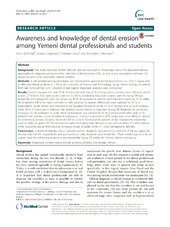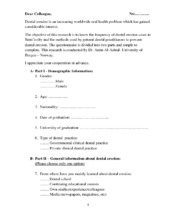| dc.contributor.author | Al-Ashtal, Amin Mohsen Saleh | en_US |
| dc.contributor.author | Johansson, Anders | en_US |
| dc.contributor.author | Omar, Ridwaan | en_US |
| dc.contributor.author | Johansson, Ann-Katrin Gerd | en_US |
| dc.date.accessioned | 2016-03-09T13:08:02Z | |
| dc.date.available | 2016-03-09T13:08:02Z | |
| dc.date.issued | 2015-10-08 | |
| dc.Published | BMC Oral Health 2015, 15:119 | eng |
| dc.identifier.issn | 1472-6831 | |
| dc.identifier.uri | https://hdl.handle.net/1956/11495 | |
| dc.description.abstract | Background: This study explored Yemeni dentists’ and dental students’ knowledge about the associated factors, approaches to diagnosis and preventive methods of dental erosion (DE), as well as any associations between DE awareness and some potentially related variables. Methods: A self-administered questionnaire was distributed to general dental practitioners (n = 323) in Sanaa and to fifth year dental students (n = 97) at the University of Science and Technology, Sanaa, Yemen during the period from July to November 2013. Descriptive and logistic regression analyses were conducted. Results: Overall response rate was 79 %. Results indicated that 61 % of respondents learned about DE from dental school, 27 % from their own studies and the rest from continuing education courses and the media. DE was reportedly most frequently seen on incisors by 46 % of respondents and on premolars and molars by 24 %. While 48 % reported DE to be more common in male patients, no gender differences were reported by 20 % of respondents. Acidic drinks were believed to be causative factors for DE by 41 % of dentists and 52 % of students, while 90 % of respondents believed that patients’ dietary history is important during DE diagnosis. As preventive measures for DE, reduction of acidic drink consumption was advised by 51 % of respondents while only 37 % advised their patients to use fluoridated toothpastes. Younger respondents (≤35 years) were more likely to identify the commonly-known causative factors for DE (P = 0.024). Twenty-seven percent of the respondents reportedly used an index to grade DE. Dental students were more likely than dentists to use such an index (P <0.001) and to more frequently advise their patients to reduce intake of acidic drinks (P = 0.02) compared to dentists. Conclusions: In-depth knowledge about causative factors, diagnosis and preventive methods of DE was apparent among only half the respondents and approaches to early diagnosis were insufficient. There would appear to be an urgent need for enhancing awareness and knowledge about DE within the Yemeni dental community. | en_US |
| dc.language.iso | eng | eng |
| dc.publisher | BioMed Central | eng |
| dc.relation.ispartof | <a href="http://hdl.handle.net/1956/15255" target="_blank">On dental erosion among Yemeni children, adolescents, dentists and dental students. Prevalence, scoring system, risk indicators and awareness</a> | eng |
| dc.relation.uri | http://www.biomedcentral.com/1472-6831/15/119 | |
| dc.rights | Attribution CC BY | eng |
| dc.rights.uri | http://creativecommons.org/licenses/by/4.0 | eng |
| dc.subject | Awareness | eng |
| dc.subject | Dental erosion | eng |
| dc.subject | Dental students | eng |
| dc.subject | Dentists | eng |
| dc.subject | Knowledge | eng |
| dc.subject | Yemen | eng |
| dc.title | Awareness and knowledge of dental erosion among Yemeni dental professionals and students | en_US |
| dc.type | Peer reviewed | |
| dc.type | Journal article | |
| dc.date.updated | 2015-11-10T12:55:57Z | |
| dc.description.version | publishedVersion | en_US |
| dc.rights.holder | Copyright 2015 The Authors | |
| dc.identifier.doi | https://doi.org/10.1186/s12903-015-0103-x | |
| dc.identifier.cristin | 1280351 | |


